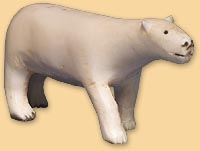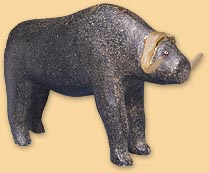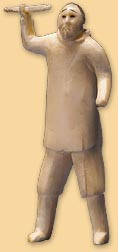 |
Lorris Elijah Borden trained as surgeon and did his internship at
Victoria Hospital in Halifax in 1902. Fresh out of medical school,
he was hired by
A. P. Low to join his government expedition on the Neptune.
While wintering over on the Neptune in Cape Fullerton on the
West Coast of Hudson Bay, Borden made a survey of diseases among the
Inuit in the area, especially with regard to cancer, syphilis and
tuberculosis. He acquired a small collection of ivories and other
artifacts, often through gifts from Inuit whom he had treated.
His collection is one of three from that area, and of that period.
The pieces all have a close stylistic resemblance to Captain Comer's
and A. P. Low's collections. Many of the more skillful carvings can be
attributed to Harry, Captain Comer's chief associate among the
Aivilingmiut.*
In 1964, a year after his death, Borden's widow donated his
collection, along with his notes and diaries, to the Public Archives
of Canada. While the papers were kept at the Archives, the artifacts
were transferred to the Canadian Museum of Civilization.*
*von Finckenstein, Maria
2000 – "Harry Teseuke, Captain Comer's Mate: Historic Ivories
at the Canadian Museum of Civilization, part II." Inuit
Art Quarterly 17(4): 44.

 |
Polar Bear, 1903–1904
Fullerton Harbour, West Coast of Hudson Bay, Nunavut
Ivory, black colouring
3 x 7 x 1.8 cm
CMC IV-X-551
Gift of Mrs. Ethel K. Borden, Ottawa, 1964
Collected by Dr. Borden during the Neptune expedition in 1903–1904
|
 |
The signature "Harry," in brown ink on the belly of this
piece, allows us to attribute it to Harry Teseuke, Comer's chief Inuit
collaborator. On January 13, 1904, Borden notes in his diary: "Harry,
native, made me a few figures from ivory."
References:
von Finckenstein, Maria
2002 – "Harry Teseuke, Captain Comer's Mate: Historic Ivories
at the Canadian Museum of Civilization, part II." Inuit
Art Quarterly 17(4): ill. p. 45.
Man with Rifle, Crawling on his Belly, 1903–1904
Fullerton Harbour, West Coast of Hudson Bay, Nunavut
Ivory, black colouring
2.5 x 10 x 2.1 cm
CMC IV-X-559
Gift of Mrs. Ethel K. Borden, Ottawa, 1964
Collected by Dr. Borden during the Neptune expedition in 1903–1904
|
 |
A hunter, stalking a seal, is caught at the moment he approaches it,
while the animal takes a nap on the ice. This kind of sealing was done
in the spring. The hunter mimics blowing, and other noises made by the
seal, in order to lull the animal into a sense of safety.
References:
Martijn, Charles
1967 – "A Retrospective Glance at Canadian Eskimo Carving."
Beaver Magazine. Autumn 1967, ill. p. 11.
von Finckenstein, Maria
1999 – "A Few Things in the Way of Curios: Historic Ivories
at the Canadian Museum of Civilization." Inuit Art
Quarterly 14(4):
ill. p. 30.
 |
Musk Ox, 1903–1904
Fullerton Harbour, West Coast of Hudson Bay, Nunavut
Stone, musk-ox horn
6.5 x 9.5 x 3 cm
CMC IV-X-537
Gift of Mrs. Ethel K. Borden, Ottawa, 1964
Collected by Dr. Borden during the Neptune expedition in
1903–1904
|
 |
Stone sculpture seems to be rare during the historic Inuit art period.
Judging by other collections, such as those of Leden and Hawkes, stone
sculpture was more prevalent on the West Coast of Hudson Bay. There are
two stone musk oxen in Borden's collection.
Exhibition History:
Arctic Mirror. Canadian Museum of Civilization, Hull, Quebec,
January 25 – September 9, 1990. No catalogue.
Sculpture/Inuit: Masterworks of the Canadian Arctic.
Organized by the Canadian Eskimo Arts Council. Vancouver Art Gallery,
Vancouver, B.C. , November 9 – December 9, 1971; Le Grand Palais,
Paris, France, February 10 – April 2, 1972; Nationalmuseet, Copenhagen,
Denmark, April 26 – May 28, 1972; The Hermitage, Leningrad, Russia,
June 29 – July 23, 1972; Pushkin Fine Arts Museum, Moscow, Russia,
August 10 – September 10, 1972; Burlington Gardens Museum, London,
England; October 5 – December 10, 1972; Philadelphia Museum of Art,
Philadelphia, U.S., January 24 – March 4, 1973; National Gallery of
Canada, Ottawa, May 17 – June 17, 1973.
Hunter with Spear, 1903–1904
Fullerton Harbour, West Coast of Hudson Bay, Nunavut
Ivory, black colouring
8.1 x 3.5 x 5.5 cm
CMC IV-X-575
Gift of Mrs. Ethel K. Borden, Ottawa, 1964
Collected by Dr. Borden during the Neptune expedition in
1903–1904
|
|
 |
 |
Similar to pieces in Low's collection, a hunter is shown in action,
at the moment before he is ready to throw his spear. To capture a
person's posture while in motion is unusual in this period of historic
Inuit art. This figure presents a much greater challenge, and demands
greater skill, than the stiff, motionless figures found in other areas.
References:
von Finckenstein, Maria
1999 – "A Few Things in the Way of Curios: Historic Ivories
at the Canadian Museum of Civilization." Inuit Art
Quarterly 14(4): ill. p. 32.
|